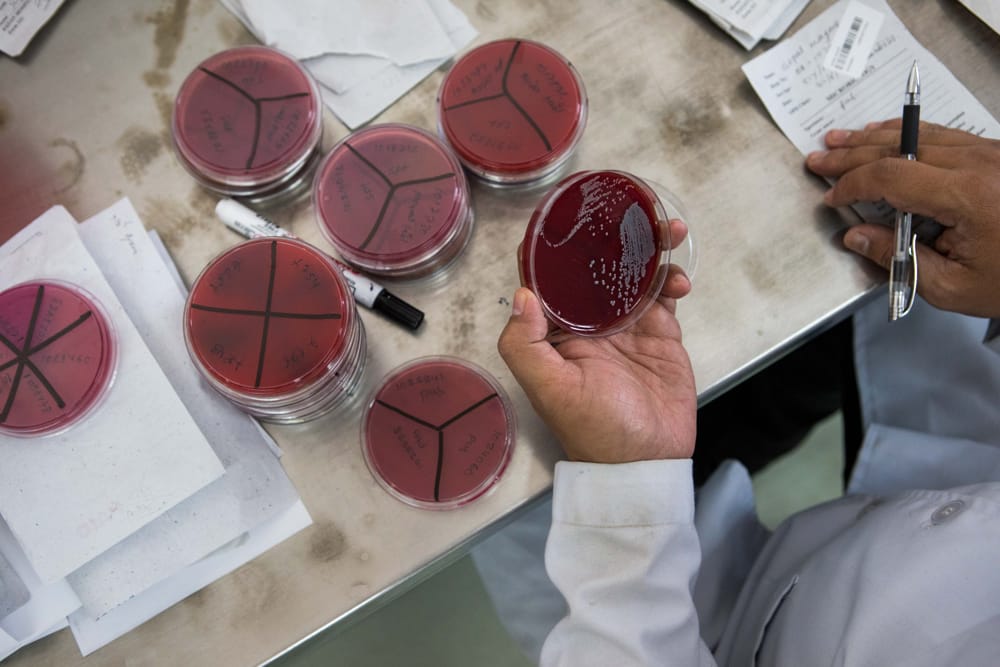Surveillance for Invasive Pneumococcal Disease
In this study

Streptococcus pneumoniae bacteria (pneumococcus) is a major cause of disease and disability worldwide, and is vaccine-preventable. In 2015, the Ministry of Health of Nepal began providing a 10-valent pneumococcal conjugate vaccine to infants (PCV10) as the vaccine was introduced into its routine infant immunization schedule.
Monitoring hospitalized cases of disease over time
The long-term monitoring of disease, (disease surveillance), allows public health professionals to see trends over time. Surveillance of children admitted to Kathmandu’s Patan Hospital paediatric ward with presumed invasive bacterial disease or pneumonia has continued uninterrupted and with unchanged methods since 2005. These data are helping the Pneumo Nepal Project provide a holistic understanding of the burden and distribution of pneumococcal disease before and after vaccine introduction.
More than 90 distinct pneumococcal serotypes have been identified throughout the world, however only a small number of these serotypes cause the majority of disease in infants. The two pneumococcal conjugate vaccines (PCVs) available on the market protect against ten (PCV10) and thirteen (PCV13) of the most common serotypes, respectively. Decisions about which product to introduce in Nepal were informed by the available evidence from Patan Hospital's surveillance.
Based on specimens collected in the 10 years prior to vaccine introduction, the Pneumo Nepal study estimated that PCV10 would cover 75% of serotypes responsible for cases of invasive disease detected since 2005, and that the three additional serotypes included in the PCV13 product would only increase this coverage by 4%. The same data indicated that the majority of cases of invasive pneumococcal disease were caused by serotypes included in PCV10, suggesting that the vaccine could offer significant protection against pneumococcal disease in Nepal.
Fig. 1 Before Nepal’s introduction of PCV10 (2005-2015), most cases of invasive pneumococcal disease were caused by vaccine-preventable types
Since mid-2009 all admissions, of any cause, to the paediatric ward at Patan Hospital have been recorded daily. Among these children, those with suspected IBD are identified and a detailed case record form has been completed, including demographic information, clinical features and laboratory results. These data form the basis of the childhood IBD surveillance program at Patan Hospital.
Surveillance Data results
Using the surveillance data the distribution of pneumococcal serotypes in children with microbiologically confirmed invasive pneumococcal disease (IPD) before (2014-2015) and after(2016-2019) PCV10 introduction in Nepal in 2015. Results showed that Pre-introduction, 27.3% of IPD cases were age <2years, the ratio of vaccine-type to non-vaccine-type IPD among <2y olds was 5:1 (among ≥2y olds, the ratio was 13:1), after introduction these numbers were 13.9% and 2:3 respectively. Most vaccine-type IPD was serotype 1: 3/7 among <2 year olds (n=1 postvaccine); 29/34 among ≥2 year olds (n=17/19 post-vaccine were >4 years old). Among 44 IPD cases detected from blood, 36 (82%) were vaccine-type (n=29 were ST1), and 7 were non-vaccine-type (6C, 10A (n=2), 19A, 24F, 38, 41).
In 2019, specifically, there were 17 cases of invasive pneumococcal disease recorded. Information on serotype was available for 15 cases which included 11 (73%) cases of serotype 1, and one each of serotypes 3, 5, 6B and 19A disease. Figure 3 displays the number of cases of invasive disease over time by categories according to vaccine-type.
Fig. 1 Cases of invasive pneumococcal disease by year and vaccine type (IBD surveillance)
Analysis of surveillance data as an indicator of vaccine impact is ongoing. For more information, contact our study coordinator.



